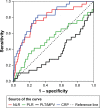Neutrophil to lymphocyte ratio is a better indicator of COPD exacerbation severity in neutrophilic endotypes than eosinophilic endotypes
- PMID: 30233162
- PMCID: PMC6130304
- DOI: 10.2147/COPD.S170353
Neutrophil to lymphocyte ratio is a better indicator of COPD exacerbation severity in neutrophilic endotypes than eosinophilic endotypes
Abstract
Background: Complete blood count parameters provide novel inflammatory markers, namely neutrophil to lymphocyte ratio (NLR) and platelet to lymphocyte ratio (PLR). We aimed to assess any differences in these novel inflammatory markers according to exacerbation severity in patients with COPD in both eosinophilic and neutrophilic endotypes.
Method: This retrospective cross-sectional study was conducted at a tertiary education hospital. Previously diagnosed COPD patients admitted to the hospital with acute COPD exacerbation (AECOPD) were enrolled into the study. Patients were grouped according to COPD endotype, eosinophilic (peripheral blood eosinophil rate ≥2%) and neutrophilic (peripheral blood eosinophil rate <2%), and further subdivided according to place of admission (outpatient clinic, ward, or intensive care unit [ICU]) as an indicator of disease severity. Complete blood count, biochemistry, C-reactive protein (CRP), NLR, PLR, and platelet to mean platelet volume values were recorded from an electronic hospital database system and compared among all groups.
Results: Of the 10,592 patients included in the study, 7,864 were admitted as outpatients, 2,233 to the wards, and 495 to ICU. Neutrophilic COPD patients (n=6,536, 62%) had increased inflammatory markers compared with eosinophilic COPD patients (n=4,056, 38%); median NLR was 5.11 vs 2.62 (P<0.001), PLR was 175.66 vs 130.00 (P<0.001), and CRP was 11.6 vs 7.7 (P<0.001). All values increased relative to admission to the outpatient clinic, ward, or ICU: median NLR was 3.20, 6.33, and 5.94, respectively, median PLR was 140.43, 208.46, and 207.39, respectively, and median CRP was 6.4, 15.0, and 22.8, respectively. The median NLR values of patients in outpatients/ward/ICU increased in neutrophilic and eosinophilic endotypes: 4.21/7.57/8.60 (P<0.001) and 2.50/3.43/3.42 (P=0.81), respectively. CRP showed a similar increased pattern according to severity of AECOPD endotypes.
Conclusion: In COPD exacerbation, the inflammatory markers show different increases in each COPD endotypes. These findings may be crucial for defining exacerbation endotypes, the severity of exacerbation, and treatment response during follow-up in COPD patients.
Keywords: COPD attack; hospitalization; inflammatory biomarkers; outpatients; ward and intensive care.
Conflict of interest statement
Disclosure All the authors who have contributed to the study design do not have any industry relationships for the past 2 years. The manuscript has been read and approved by all the authors, and each author believes that the manuscript represents honest work. The authors report no conflicts of interest in this work.
Figures



Similar articles
-
The utility of inflammatory markers to predict readmissions and mortality in COPD cases with or without eosinophilia.Int J Chron Obstruct Pulmon Dis. 2015 Nov 11;10:2469-78. doi: 10.2147/COPD.S90330. eCollection 2015. Int J Chron Obstruct Pulmon Dis. 2015. PMID: 26648709 Free PMC article.
-
Prognostic role of neutrophil-lymphocyte ratio and platelet-lymphocyte ratio for hospital mortality in patients with AECOPD.Int J Chron Obstruct Pulmon Dis. 2017 Aug 3;12:2285-2290. doi: 10.2147/COPD.S141760. eCollection 2017. Int J Chron Obstruct Pulmon Dis. 2017. PMID: 28814856 Free PMC article.
-
Alterations of the neutrophil-lymphocyte ratio during the period of stable and acute exacerbation of chronic obstructive pulmonary disease patients.Clin Respir J. 2017 May;11(3):311-317. doi: 10.1111/crj.12336. Epub 2015 Aug 6. Clin Respir J. 2017. PMID: 26096858
-
Prognostic value of platelet and neutrophil to lymphocyte ratio in COPD patients.Expert Rev Respir Med. 2020 Jan;14(1):111-116. doi: 10.1080/17476348.2019.1675517. Epub 2019 Oct 13. Expert Rev Respir Med. 2020. PMID: 31577911 Review.
-
Defining the role of neutrophil-to-lymphocyte ratio in COPD: a systematic literature review.Int J Chron Obstruct Pulmon Dis. 2018 Nov 5;13:3651-3662. doi: 10.2147/COPD.S178068. eCollection 2018. Int J Chron Obstruct Pulmon Dis. 2018. PMID: 30464448 Free PMC article.
Cited by
-
Blood eosinophil count-guided corticosteroid therapy and as a prognostic biomarker of exacerbations of chronic obstructive pulmonary disease: a systematic review and meta-analysis.Ther Adv Chronic Dis. 2021 Jul 7;12:20406223211028768. doi: 10.1177/20406223211028768. eCollection 2021. Ther Adv Chronic Dis. 2021. PMID: 34285789 Free PMC article.
-
Association Between Routine Blood Biomarkers and Clinical Phenotypes and Exacerbations in Chronic Obstructive Pulmonary Disease.Int J Chron Obstruct Pulmon Dis. 2020 Mar 31;15:681-690. doi: 10.2147/COPD.S240720. eCollection 2020. Int J Chron Obstruct Pulmon Dis. 2020. PMID: 32280207 Free PMC article.
-
Role of Systemic Inflammatory Reaction in Female Genital Organ Malignancies - State of the Art.Cancer Manag Res. 2021 Jul 9;13:5491-5508. doi: 10.2147/CMAR.S312828. eCollection 2021. Cancer Manag Res. 2021. PMID: 34276227 Free PMC article. Review.
-
Predictive Role of White Blood Cell Differential Count for the Development of Acute Exacerbation in Korean Chronic Obstructive Pulmonary Disease.Int J Chron Obstruct Pulmon Dis. 2024 Jan 4;19:17-31. doi: 10.2147/COPD.S435921. eCollection 2024. Int J Chron Obstruct Pulmon Dis. 2024. PMID: 38192972 Free PMC article.
-
Short-term exposure to air pollution on peripheral white blood cells and inflammation biomarkers: a cross-sectional study on rural residents.BMC Public Health. 2024 Jun 26;24(1):1702. doi: 10.1186/s12889-024-19116-2. BMC Public Health. 2024. PMID: 38926692 Free PMC article.
References
-
- Global Initiative for Chronic Obstructive Lung Disease [home page on Internet] Global Strategy for Diagnosis, Management, and Prevention of COPD (updated 2012) [Accessed August 25, 2016]. Available from: http://www.goldcopd.org.
-
- Sethi S, Murphy TF. Infection in the pathogenesis and course of chronic obstructive pulmonary disease. N Engl J Med. 2008;359(22):2355–2365. - PubMed
-
- Papi A, Bellettato CM, Braccioni F, et al. Infections and airway inflammation in chronic obstructive pulmonary disease severe exacerbations. Am J Respir Crit Care Med. 2006;173(10):1114–1121. - PubMed
Publication types
MeSH terms
LinkOut - more resources
Full Text Sources
Other Literature Sources
Medical
Research Materials
Miscellaneous

